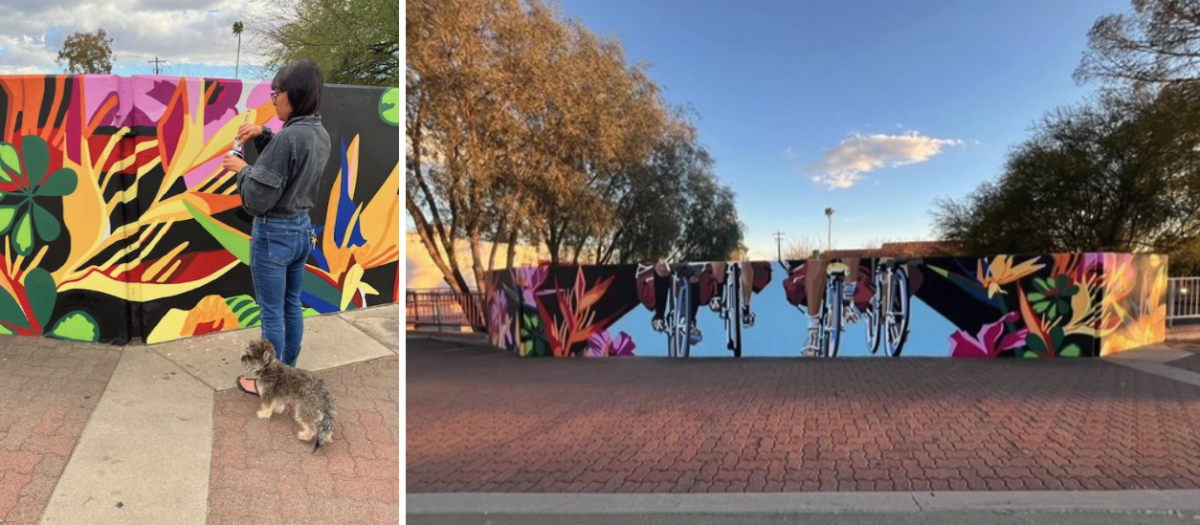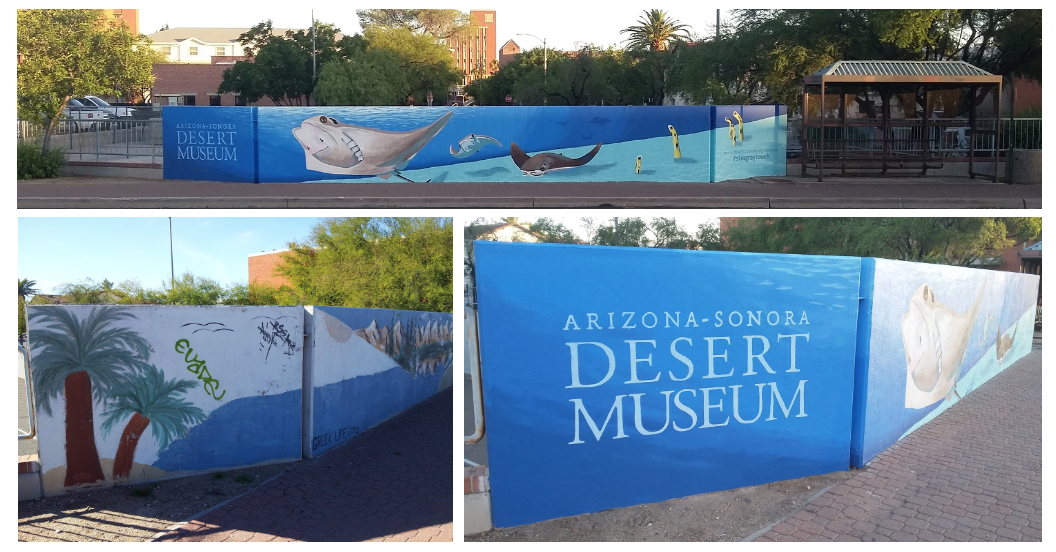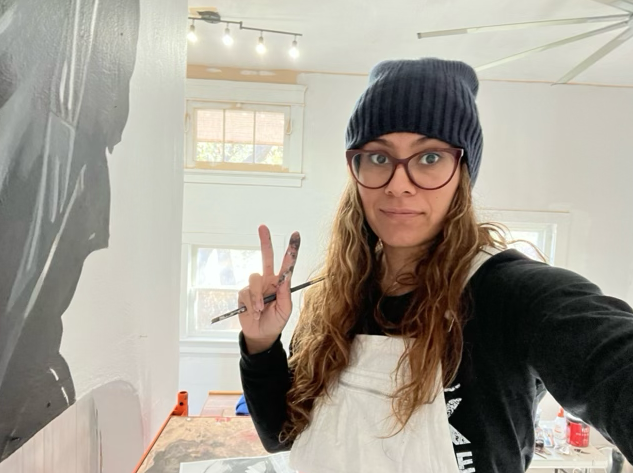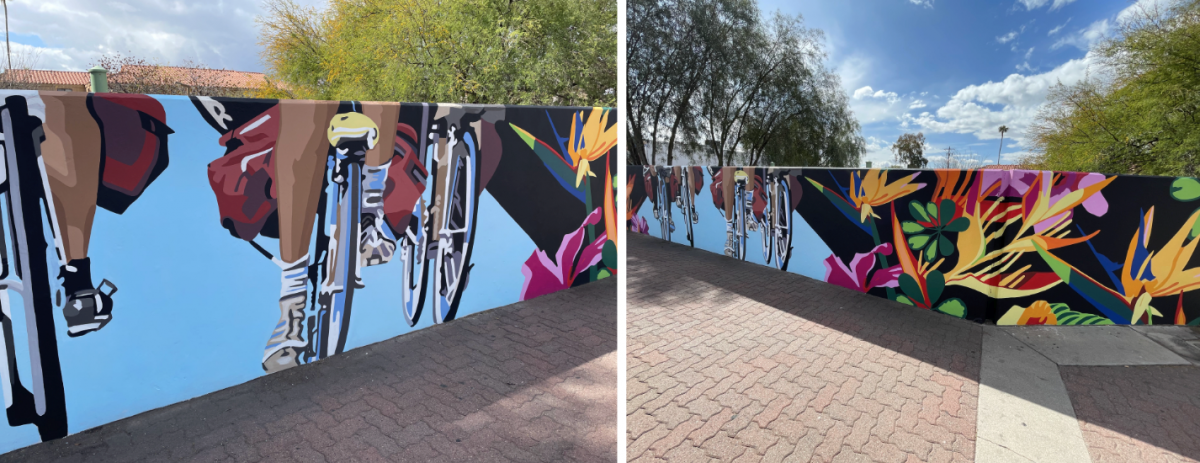In this series of interviews, Melissa Goodrich speaks to the 6 artists who created poetry-inspired murals along the Speedway corridor. Today's interviewee is Allison Miller.
The walls are owned by us: you, me, the city.
We have a right to public art.
We have a right to see beautiful things on our property.
—Allison Miller

The haiku reads: “On the open road/ Revolutionary love/ turns wheels into wings.”
How did you become a muralist?
I've been a muralist, I think, for 20 years. I started in high school as part of the program where I got paid to learn how to make a mural. And my father was a muralist in Tucson, so I really tried to follow in his footsteps.
How would you describe your style or your influences? How would someone know it's your mural?
That's one of the things I like to avoid is people knowing it's me. Part of my philosophy as a public artist is that it's not necessarily about me and that it’s no longer mine, it’s the communities. And usually I work with clients who want murals, and a lot of times it's about what they have wanted. So I haven’t really put up something that's my style until this project, that’s fully mine.
How did it feel to make something that was just yours and didn't need to conform to someone else's vision?
It was really emotional. I've been working on this project for almost a decade, trying to make it happen in one way or another. And it was also kind of an homage to my parents who have helped me make public art. It was quite emotional, but exciting. It was such an honor that the Poetry Center bestowed upon all six of us.

between Campbell and Park near various public transit stops near the University of Arizona.
This is a grassroots public art project being organized by Allison Miller of Alley Cat Murals along with five other local Tucson artists.
You said this project was ten years in the making. Can you tell me where this idea came from and why it took so long?
When I was in high school or little after high school, I noticed these walls, specifically, two of them had dilapidated murals on them. And I always wondered, well, what was that project? Why didn't they get finished?
And about ten years ago, I worked with the Desert Museum [to create a stingray mural], and we highlighted a conservation effort they put forward. The idea was to get some volunteer opportunities in town and advertise the place. And it was beautiful.
And then the city said, “Actually, you never had permission to paint that mural …” And as a volunteer, I did all of that without getting paid. It was hard to prioritize it.
And finally, the stingray mural kept getting graffitied and—it's funny because the city would reach out to the Desert Museum and say, “Hey, your murals’s graffiti-ed; you need to paint over it.” And I hadn’t worked for the Desert Museum in so long and the mural no longer interested me. I was more interested in having something totally unique up that wasn't about another institution.

That is quite a journey you've been on.
Yeah. And it's interesting because those walls were always so cute. And they are perfect for public art. They are next to the U of A. They're on this really busy corridor. They’re at bus stops. And I just always wanted there to be murals on there. But it's funny, no one ever painted them.
And the way bureaucracy worked is that no one knew who owned these walls until I raised the question. The funny thing about the walls is when they really looked into it, the middle part is owned by the city of Tucson. The wings are owned by the University of Arizona.
That's so crazy!
So we had to get dual permission from the city and from the University and a big part of me just wanted to put these murals up in protest of that bureaucracy. The walls are owned by us, you, me, the city, the members of the city. We have a right to public art. We have a right to see beautiful things on our property.
I go back to cave painting—that deep need in our psyche to tell stories,
the thing makes us human is that we marked up walls.
We had to tell stories. We wanted it to last a long time.

I would love to hear a little bit more about why you think public art is so important.
I go back to cave painting—that deep need in our psyche to tell stories, the thing that separates us from anybody and makes us human is that we marked up walls. We had to tell stories. We wanted it to last a long time. We thought about how it was preserved. And that just hasn't gone away, you know?
It's a way that we, as public artists, provide access to art and that fundamental need to create to the public, not necessarily private institutions like a gallery or a museum.
People of privilege access those spaces. You know, a lot of times people don't care about walking into a gallery or trying to understand the art because they have realistic things to be caring about, everyday things to be preoccupied with. And they might be driving by and see this inspirational, beautiful thing that they have a right to have, that they have a right to see.
I think it also is an example of a healthy community, a healthy neighborhood, a safe space. I've done murals in a park with a heavily graffitied wall. The park was really sweet but wasn't being used. And we put a mural over that graffiti. The park was revitalized. People started using the space.
So I think murals have the capability of transforming the context of public access, of public space.

Can you tell me the poem that inspired your mural? How did you take those words and turn them into this visual medium?
My mural's different than the other five because I went into this project coordinating an opportunity for six other people. I already have murals up. I had the stingray mural up. I already had this really public presence and the idea of this project was to highlight some artists that haven't been featured.
I wanted to pick six people who deserved a mural being highlighted publicly. Like Monique—this was their first public mural. Jodie’s an up-and-comer and really deserved a wall that was going to be there for an indefinite amount of time. Alex has been putting up graffiti for a decade. He deserved something that was going to be prominent. And Sasha is such a good friend of mine and so humble—she needed to have something bigger. A lot of her murals are kind of tucked away.
A couple other people were involved in the mural, but, you know, with a year's worth of coordinating things, people got busy, people lost interest. So I had about maybe three artists back out. And in the end, time was so sensitive that I jumped on board and did one of the murals.
I commissioned Maddie to write a poem based on my idea—so, a little backward. She's a bike mechanic. She is someone who writes poems about biking and friendship and trips. And I know she's taken many bike trips, so she felt really appropriate to write off of this theme.
Would you be able to share the poem with me?
Yes, I can read it for you really quick. It’s a haiku.
On the open road
Revolutionary love
turns wheels into wings.
Did you say ‘turns wheels into wings’?
Yeah. I think the birds of paradise is being represented there. But it's also because my parents are a mixed-race couple, and back in the seventies that was very taboo. So their love was quite revolutionary.
That's gorgeous. I love how each mural has its own story as well as the story of the whole project.
Yeah, I like how we had different poems and different ways of being inspired by those words or the actual poet. And as an artist, it was really cool for me to see how we all put up our murals using a different process. Monique and I used a gridding process. Alex used this doodle grid method, Sasha did freehand. Jenna did a stencil, and Jodie did projection.
So if anybody does a case study on this or uses it to teach kids how to make a mural, we all did different techniques and I thought, that's awesome.

I have a question that's similar to my question about why you think public art is important. Why do you think poetry is important?
That's a great question! I will give my own example of why Maddie was someone I picked. And I've noticed the way they put up poetry is a lot like how I put out public work.
She's got an Instagram and like every day she's writing haiku. She puts it up, and she keeps doing it just because—just because like, she needs to do it. It's something inside her. She's got to write haikus.
She doesn't care if people read them. She doesn't care if people like them. They're just flowing out of her as if she's got to give people access to this thing. And I think that's definitely how I make public art.
I'm curious if you get to make art full time or do you spend your days doing a ‘day job’?
I've been really careful to make sure I always have a job because I don't want anyone dictating my artistic process or my artistic opportunities. I want to be in a position where I can turn something down.
So I never wanted to turn this into a full time job because—we all don't want to go to work, you know? And the more I depend on this as my only source of income, the more I probably won't enjoy it to the extent I do now. So right now I am teaching art at Sunnyside.
Was there anything we didn't talk about that you wanted to share?
Just how grateful I am to Tyler and the Poetry Center. The Poetry Center has been so generous and supportive. We've done several murals for you in the center and I think that Tyler is a really beautiful human being, and I'm really thankful he's part of our community. And it feels really special that he trusted the project enough and saw the vision I saw and he’s probably one of the biggest reasons this project was made. You know, it was my crazy idea, but so many people jumped on board to get it done. But it feels like it was supposed to be made, and it’s much bigger than me.
It's such a beautiful thing to see all of these murals come together. I took a short walk before they went up and took pictures of some of the blank walls. And I almost can't remember what it was like before they were there.
Yeah, I think people just didn't know where these walls were. But they see them all the time, but they don't register them, and hopefully now they do.
I really hope that your philosophy about art belonging to the public and that we all deserve to have it in our sights. I really hope you see that coming to fruition.
I do, yeah. I do. It's very emotional. Yeah.
____
Allison Miller (@alycatmiller) is a painter and second generation Tucson muralist. Allison is the founding artist of Alley Cat Murals, an organization made up of local muralists restoring and revitalizing community spaces. As a member of Alley Cat Murals, Allison coordinates public art initiatives, typically funded by direct action and volunteer support. In 2019, Allison was given Buffalo Exchanges’ Visual Artist Award for her work in the community. Much like Allison’s personal work, Alley Cat Murals focuses on stewarding projects that celebrate diversity and serve as restitution to those who are underrepresented in shared spaces.

